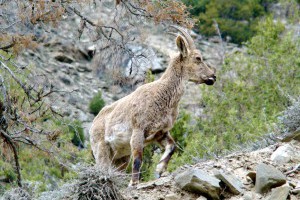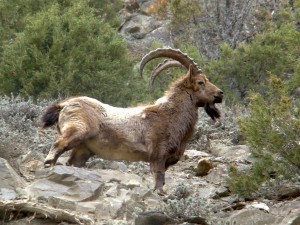
Capra sibirica (Himalayan Ibex)
The Himalayan Ibex (Capra sibirica) is one of the most iconic wild mountain goats found in the high-altitude regions of the Great Himalayan National Park (GHNP). Known for its striking appearance and superb climbing abilities, this species is an essential component of the park’s high-altitude ecosystem. The presence of the Himalayan Ibex in GHNP highlights the park’s rich biodiversity and importance as a conservation site.
Appearance and Adaptations
The Himalayan Ibex is a robust animal with a thick brown coat, long curved horns, and strong limbs adapted for navigating steep cliffs and rocky terrain. Males have particularly long, backward-curving horns, which can grow over a meter in length. This physical strength and agility enable them to survive in harsh alpine environments, often at elevations above 3,000 meters.
Habitat in GHNP
Within the Great Himalayan National Park, the Himalayan Ibex inhabits rugged mountain slopes, alpine meadows, and cold deserts. These regions offer safety from predators and limited human disturbance, making GHNP a crucial stronghold for the species. During summer, Ibex can often be seen grazing in high-altitude pastures, while in winter, they descend to lower elevations.
| Common name | Himalayan Ibex |
| Latin name | Capra sibirica |
| Local name | Tangrol |
| IUCN/WPA/Indian status | Least Concern/I/Uncommon |
| Social unit | Large feeding aggregations of up to 100 animals can be seen in spring, average herd size |
| Size / weight | 10-15 Size HBL 103-132 cm (male), 85-101 cm(female),HAS 65-105 cm, HL 90-148 cm (male), 19-39 cm (female) Weight 60-130 Kg ( male ), 30-56 kg (female) |
| Description | The Himalayan Ibex male is easily told apart from other caprids by his characteristic horn and beard. Female are grey brown in colour with less distinct white underpants, have thin parallel horns and dark markings on their legs. Both sexes have a dark dorsal stripe down the length of their back and short dark furry tails |
| Behavior | The Ibex does not always migrate to lower heights in winter and mostly stays at fairly high altitude using wind blown ridges. Unlike other caprids, the Ibex is known to dig crates through snow to access forage in winter |
| Distribution | Trans Himalayas region of Ladakh and the Greater Himalayas and Pir Panjals of Jammu & Kashmir and Himachal Pradesh. The eastern limit seems to be the Bara Lacha La Pass on the north and Satluj Gorge south of the Great Himalayan Range in Himachal Pradesh. The Southern most populations may occur south of the Pir Panjal Range in Manali WLS in Himachal Pradesh. |
| Habitat | Steep crags above the tree line in the Himalayas up to 5500 m. In Himalayas frequents 3400-4400 m. while in trans Himalayas frequents 4000-4725 m. Grazes on alpine pastures and wet meadows but always close to rocky precipitous terrain. Occasionally enters forests. |
| Best seen | Pin Valley NP, Himachal Pradesh, Kanji WLS, Jammu and Kashmir |
Behavior and Ecology
The Himalayan Ibex is a herbivore, feeding on grasses, herbs, and shrubs. They are social animals, typically moving in herds. During the mating season, males compete in dramatic horn clashes to win females. Their natural predators in GHNP include the snow leopard and Himalayan wolf, making the Ibex a key species in the food web.
Conservation Importance
While currently listed as “Least Concern” by the IUCN, the Himalayan Ibex is still threatened by habitat degradation and illegal hunting in many areas. However, GHNP provides them with legal protection and a safe, undisturbed habitat, which is vital for their long-term survival.
Conclusion
The Himalayan Ibex (Capra sibirica) is not just a symbol of strength and resilience in the Great Himalayan National Park, but also a crucial species in maintaining ecological balance. Protecting this majestic goat ensures the health of the entire alpine ecosystem. Observing these animals in their natural mountain environment is a remarkable experience and a testament to GHNP’s conservation success.




